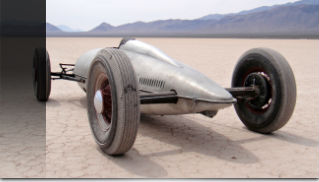 If you’re a car guy or girl, you’ve likely seen the pictures. An old black and white photo of a curious, low-slung racing car with an aluminum, torpedo-shaped body. These are racecars from another generation and are they called “Belly Tank Racers”. They were built to break speed records. To understand the significance of these unique racers requires knowledge of 1940s and 1950s Southern California hot rod culture.
If you’re a car guy or girl, you’ve likely seen the pictures. An old black and white photo of a curious, low-slung racing car with an aluminum, torpedo-shaped body. These are racecars from another generation and are they called “Belly Tank Racers”. They were built to break speed records. To understand the significance of these unique racers requires knowledge of 1940s and 1950s Southern California hot rod culture.
The body of a belly tank racer came from aluminum drop tanks, or “belly tanks”, that were common on WWII aircraft. Belly tanks were supplemental gas tanks that were strapped to the bellies of planes to provide extra fuel, which in turn provided additional flying range. When a belly tank was empty, the pilot would jettison it to reduce air drag and then continue on his mission. After World War II ended, lots of belly tanks ended up in surplus and scrap yards and Southern California hot rodders soon took notice and started making them into race cars.
The first belly tank racers used a front engine design, where the engine sat in front of the driver. They used this setup mainly because the first tanks used were 165-gallon tanks from P-51 Mustangs. When the larger 315-gallon tanks from P-38 Lightnings became available, there was instantly room to put the engine behind the driver, and that’s how most belly tank racers were designed from there on.
Most belly tank racers had American-made engines because of their availability to hot rodders at the time. America engines were plentiful and cheap. Because of the narrow profile of a belly tank, the wheels aren’t under the body of the car. Rather, they stick out to the sides in the front and rear. While it may look a little odd, it was necessary to give the vehicle stability.
Belly tank racers are hot rods that were primarily built to break land speed records. This was possible because of a unique geological attribute of the South Western part of the United States. Across California, Nevada and Utah are the dry beds of giant prehistoric lakes. These salty, wide-open expanses are flat and glass-smooth. They’re perfect for high-speed runs in vehicles made to break land speed records.
One of the most famous belly tank racers is associated with Alex Xydias and his iconic So-Cal Speed shop. Built from the belly tank of a P-38 Lightning, Xydias managed to average 195 miles per hour in his “So-Cal-Streamliner”. At the time, this was considered an impossibly high speed and it brought fame and success to his speed shop for decades to come.
Source: Bossier Chrysler Dodge Jeep